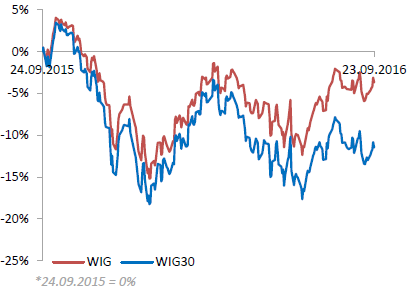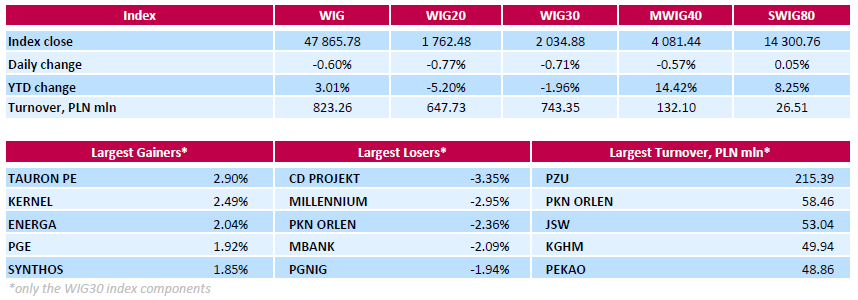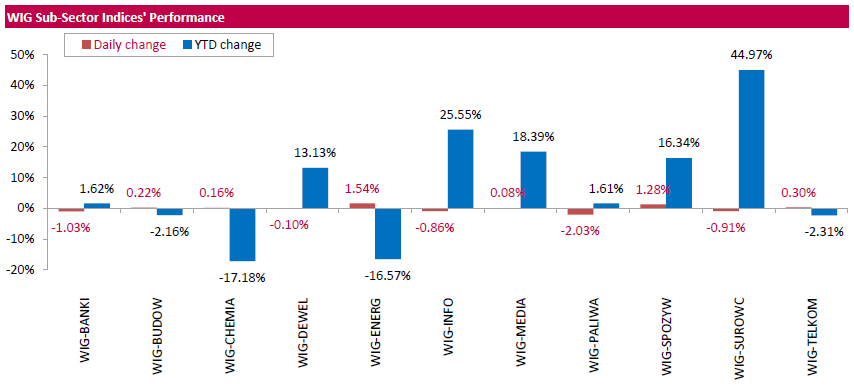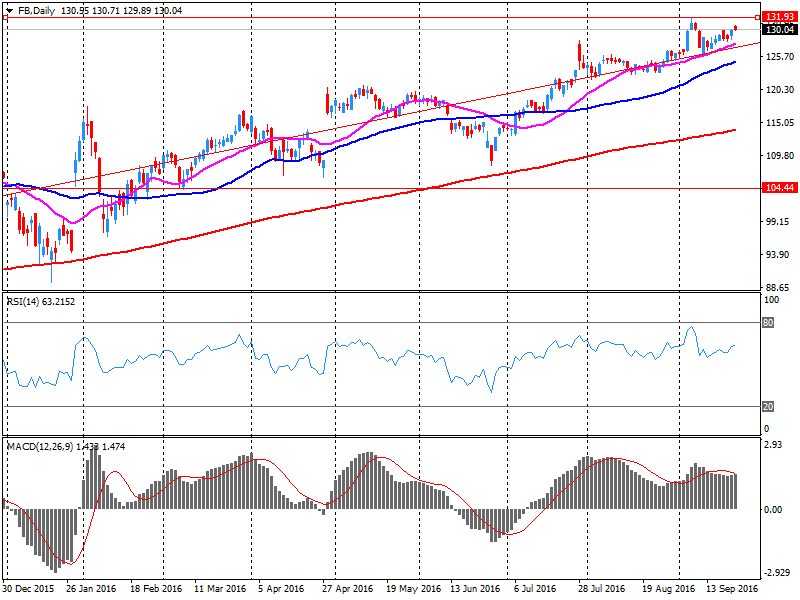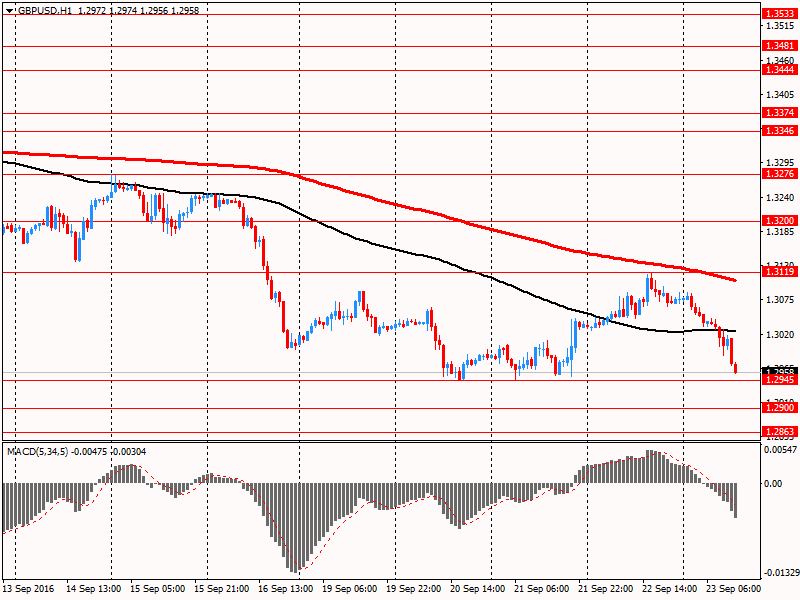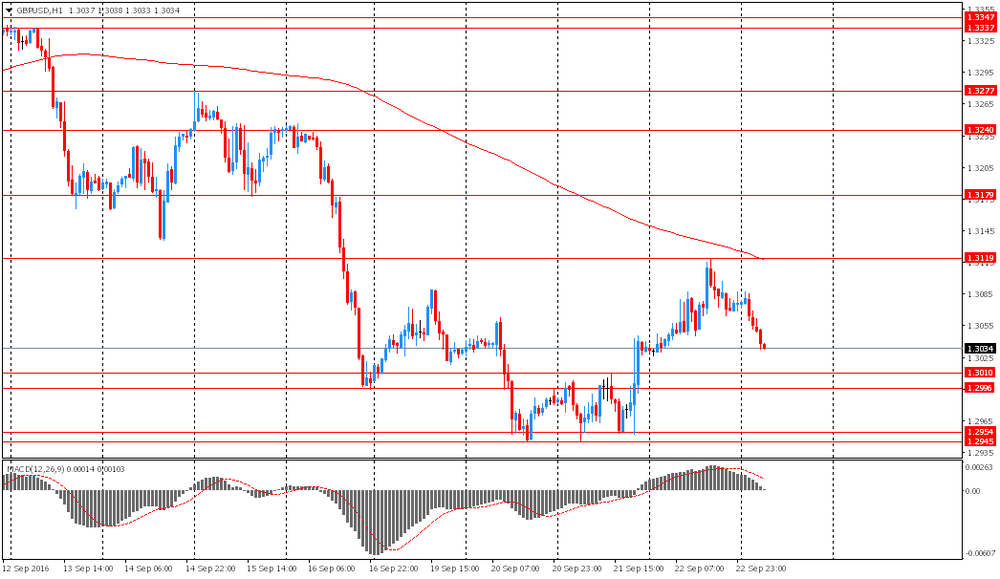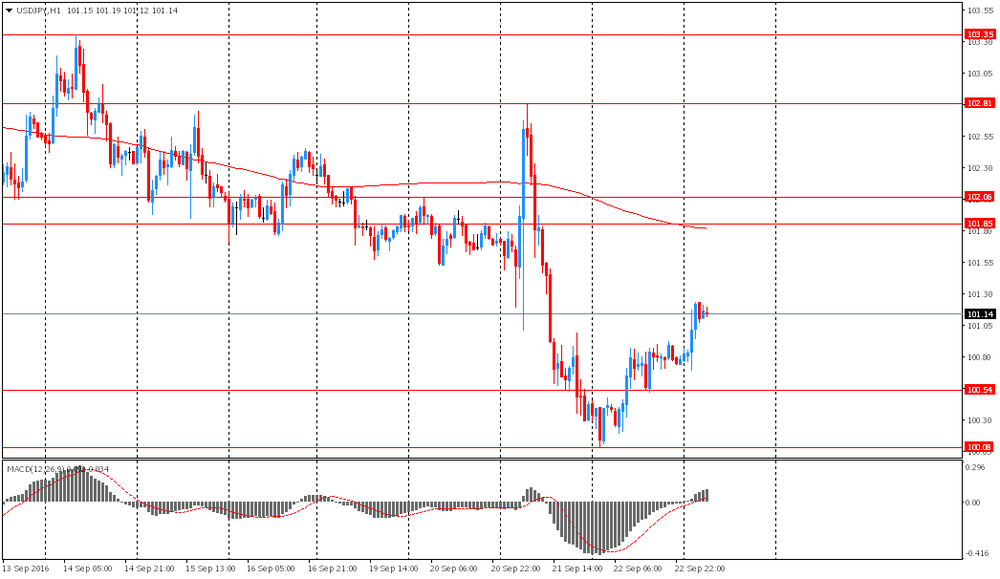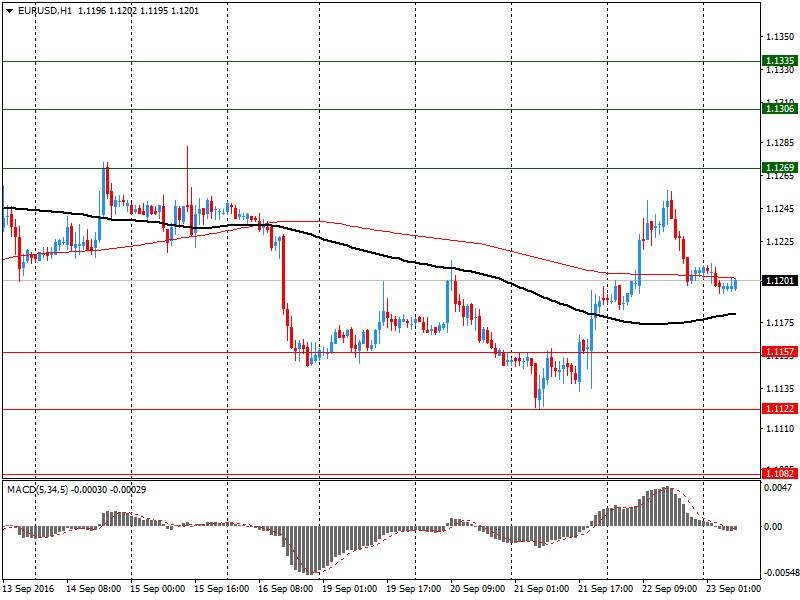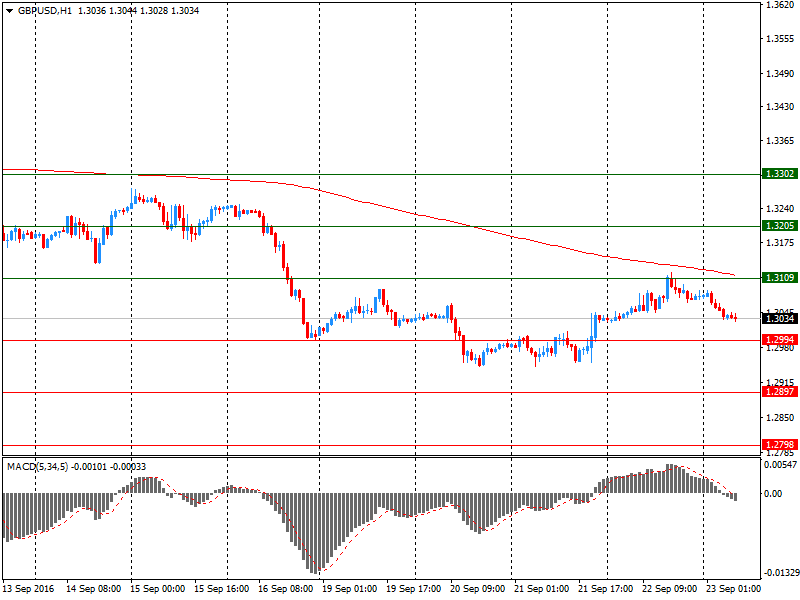Noticias del mercado
-
21:00
DJIA 18292.20 -100.26 -0.55%, NASDAQ 5311.10 -28.43 -0.53%, S&P 500 2167.59 -9.59 -0.44%
-
18:22
Wall Street. Major U.S. stock-indexes fell
Major U.S. stock-indexes lower in late morning trading on Friday as investors assess valuations after a three-day rally spurred by optimism that the Federal Reserve will hold off from raising interest rates in the near term.
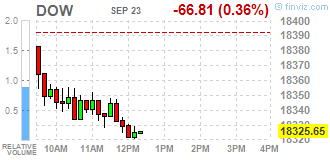
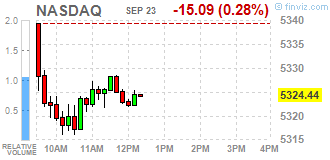
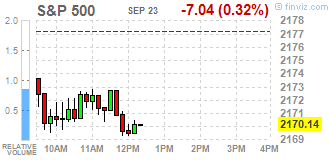
Almost all of Dow stocks in negative area (20 of 30). Top gainer - NIKE, Inc. (NKE, +0.47%). Top loser The Procter & Gamble Company (PG, -1.22%).
All S&P sectors also in negative area. Top loser - Basic Materials (-0.8%).
At the moment:
Dow 18235.00 -64.00 -0.35%
S&P 500 2161.75 -6.50 -0.30%
Nasdaq 100 4872.75 -13.50 -0.28%
Oil 44.96 -1.36 -2.94%
Gold 1341.30 -3.40 -0.25%
U.S. 10yr 1.62 -0.01
-
18:00
European stocks closed: FTSE 6909.43 -1.97 -0.03%, DAX 10626.97 -47.21 -0.44%, CAC 4488.69 -21.13 -0.47%
-
17:55
Oil little changed today
In the course of today's trading oil was moving smoothly as market participants receive mixed signals as to whether the leading oil exporters will agree to work together to eliminate the excess supply, which is observed for two years.
At the beginning of the European session, oil prices declined, however, they moved into positive territory after Reuters reported that Saudi Arabia is ready to cut production if Iran decides to limit its oil production.
Meanwhile, the representatives of Saudi Arabia and Iran are not in consultations this week to agree on how to define the levels at which can limit production. This was reported by Wall Street Journal.
Skepticism towards the OPEC meeting still persists. It is believed that the largest OPEC members, including Saudi Arabia, Iran and Iraq, will not be able to reach an agreement on the reduction or production restrictions. Geopolitical rivalry also aggravates the situation. In addition, these countries are fighting for market share.
"Even the agreement of the leading oil producers will not be positive in view of the current high level of offer. Prices may be supported only if they agree a clear and significant production cut, that under current conditions it is highly unlikely" - said Tamas Varga of PVM Oil Associates.
The cost of the November futures for US light crude oil WTI (Light Sweet Crude Oil) fell to 45.44 dollars per barrel on the New York Mercantile Exchange.
November futures price for North Sea petroleum mix of mark Brent fell to 46.93 dollars a barrel on the London Stock Exchange ICE Futures Europe.
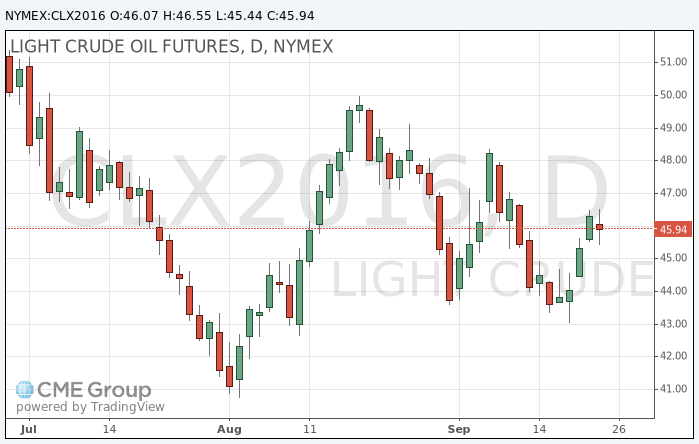
-
17:53
WSE: Session Results
Polish equity market closed lower on Friday. The broad market benchmark, the WIG Index, fell by 0.6%. Sector performance in the WIG Index was mixed. Utilities (+1.54%) recorded the biggest gains, while oil and0gas sector (-2.03%) fared the worst.
The large-cap stocks' measure, the WIG30 Index, lost 0.71%. In the index basket, videogame developer CD PROJEKT (WSE: CDR) tumbled the most, down 3.35%. Other major decliners were two banking sector names MILLENNIUM (WSE: MIL) and MBANK (WSE: MBK) as well as two oil and gas sector stocks PKN ORLEN (WSE: PKN) and PGNIG (WSE: PGN), dropping by 1.94%-2.95%. On the other side of the ledger, genco TAURON PE (WSE: TPE) led the gainers with a 2.9% advance, followed by agricultural producer KERNEL (WSE: KER), surging by 2.49%.
-
17:28
Gold moderately higher
In today's trading, gold price rose slightly after touching a 2-week high yesterday.
Gold gained after the Fed's decision to keep interest rates earlier adopted on Wednesday. Since gold does not bring interest income, it is usually more in demand at low interest rates.
While investors continue to look for signals that will help to understand when rates may be increased, a slight increase in demand for metals in China and India could support prices, said Joni Tevez, strategist at UBS.
"We believe that the volume of purchases before the end of the year is likely to be limited and lower than in previous years, however, the purchase will be significantly higher than in the first half of 2016." - Tevez said.
Physical gold is usually purchased during festivals and weddings. A good rainy season in India has traditionally support growth of incomes of those engaged in agriculture, and this segment has a particularly high demand for gold.
Support for gold prices also had a weakening US dollar after the release of the business activity data. Preliminary data released by Markit Economics showed that the index of business activity in the manufacturing sector fell in September to 51.4 points compared to 52.0 points in August. The last reading was the lowest since June. Economists had expected the index to fall to only 51.9 points. It is worth emphasizing that the index remained above 50 points since October 2009, which indicates expansion
The cost of the October futures for gold on COMEX rose to $ 1340.2 per ounce.
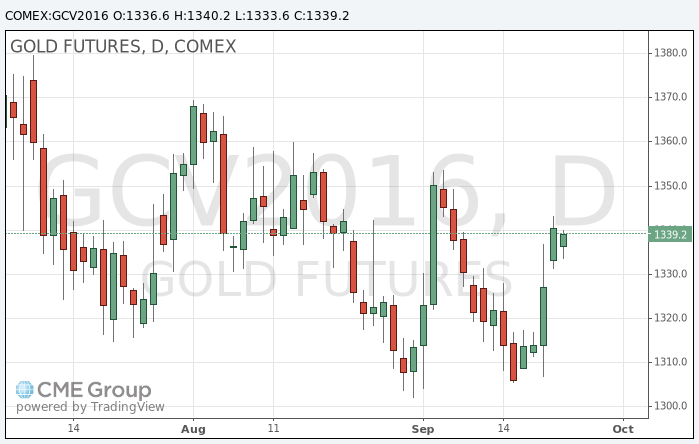
-
17:07
ECB leaning towards QE tweak, no radical changes - RTRS
-
16:30
Fed's Rosengren: Not Raising Rates Now Puts Economic Recovery at Risk
Federal Reserve Bank of Boston President Eric Rosengren said Friday that not raising interest rates now could put the economic expansion at risk by generating "significant imbalances" that could lead to a recession.
Mr. Rosengren was one of three Fed officials who cast dissenting votes at the Fed's policy meeting Wednesday, preferring to raise rates by a quarter percentage point rather than keep them steady.
-
15:54
Option expiries for today's 10:00 ET NY cut
EURUSD:1.1100 (EUR 2.0bln) 1.1150 (994m) 1.1175 (514m) 1.1200 (2.21bln) 1.1205 (297m) 1.1225-30 (443m) 1.1250 (1.96bln) 1.1400 (538m)
USDJPY: 99.50 (USD 275m) 99.99 (320m) 100.50 (USD 325m) 101.00 (980m) 101.80 250m) 103.00 (1.43bln)
AUDUSD 0.7545-55 (AUD 225m) 0.7650 (299m)
NZDUSD 0.7350 (197m)
USDCAD 1.3000-10 (USD 598m) 1.3050 (431m) 1.3150 (463m) 1.3250 (361m) 1.3300 (1.1bln)
-
15:52
WSE: After start on Wall Street
The US market started slightly lower than could be estimated based on previous contracts trading. The S&P500 lost at the opening 0.3 percent and was close to the yesterday session minimum. It does not help, of course, for the demand side on the Warsaw Stock Exchange. Additionally, in afternoon trading phase, the German DAX cosmetic downside at 0.25 percent was doubled. The scale of depreciation on the Warsaw Stock Exchange is much higher, an hour before the close of trading WIG20 index lost 1.48% reaching the level of 1,750 points.
-
15:49
US Manufacturing growth eases again in September - Markit
September data highlighted a further upturn in U.S. manufacturing output, but the rate of expansion was modest and only slightly faster than seen on average during the first half of 2016. The latest survey also pointed to a lack of momentum in terms of incoming new orders, especially from export clients.
Manufacturers indicated the slowest overall rise in new business intakes so far this year, which contributed to relatively subdued job hiring and ongoing efforts to reduce inventory levels. Meanwhile, factory gate charges were reduced slightly in September, despite another marginal increase in input costs at manufacturing firms.
At 51.4 in September, the seasonally adjusted Markit Flash U.S. Manufacturing Purchasing Managers' Index™ (PMI™ ) 1 was down from 52.0 in August and pointed to the weakest improvement in overall business conditions since June. The latest PMI reading marked seven years of continuous growth across the manufacturing sector. However, the headline index was below the average seen over this period (54.0) and remained close to the post-crisis low recorded in May (50.7).
Softer rates of output and new business growth were the main factors weighing on the headline PMI during September. Moreover, the latest expansion of manufacturing production was the weakest for three months. Survey respondents suggested that relatively subdued economic conditions had acted as a brake on new order volumes, while there were also reports that the strong dollar had dampened export sales. Reflecting this, latest data signalled that new work rose at the slowest pace since December 2015, while export orders dropped for the first time in four months.
-
15:45
U.S.: Manufacturing PMI, September 51.4 (forecast 51.9)
-
15:33
U.S. Stocks open: Dow -0.17%, Nasdaq -0.24%, S&P -0.25%
-
15:25
Before the bell: S&P futures -0.07%, NASDAQ futures -0.09%
U.S. stock-index futures were little changed as investors assessed a rally spurred by central-bank optimism.
Global Stocks:
Nikkei 16,754.02 -53.60 -0.32%
Hang Seng 23,686.48 -73.32 -0.31%
Shanghai 3,033.79 -8.52 -0.28%
FTSE 6,903.96 -7.44 -0.11%
CAC 4,484.10 -25.72 -0.57%
DAX 10,633.26 -40.92 -0.38%
Crude $46.22 (-0.22%)
Gold $1343.70 (-0.07%)
-
15:10
Twitter shares jump 15% on sale rumors
-
15:06
WSJ: Facebook (FB) overstated ad figures on the network for two years
According to the WSJ, citing sources familiar with the situation, large advertisers and sellers of advertising space are disappointed after learning that FB significantly overestimated the average duration of video viewing on its platform, in the last two years.
A few weeks ago, reports surfaced that the rate of content was artificially inflated because it took into account only those videos that have been viewed by more than three seconds. The company also announced that it is introducing a new calculation criteria, to solve this problem.
Directors of some companies, which Facebook has notified about the changes, requested more details on the calculations, the sources said.
It is thought that the previous method of calculation inflated figures by 60-80%.
The news is negative for Facebook, which is "praising" the rapid growth of "consumer" video through its platform in recent years.
FB shares fell in premarket trading to $ 126.92 (-2.43%).
-
15:01
Wall Street. Stocks before the bell
(company / ticker / price / change ($/%) / volume)
ALCOA INC.
AA
9.72
-0.06(-0.6135%)
4500
Amazon.com Inc., NASDAQ
AMZN
804
-0.70(-0.087%)
9958
Apple Inc.
AAPL
114.5
-0.12(-0.1047%)
77984
Barrick Gold Corporation, NYSE
ABX
18.7
0.17(0.9174%)
55450
Boeing Co
BA
131.8
-0.07(-0.0531%)
642
Citigroup Inc., NYSE
C
47.05
-0.06(-0.1274%)
3327
Exxon Mobil Corp
XOM
83.6
0.06(0.0718%)
6802
Facebook, Inc.
FB
127.55
-2.53(-1.945%)
2147387
Ford Motor Co.
F
12.16
-0.02(-0.1642%)
12528
Freeport-McMoRan Copper & Gold Inc., NYSE
FCX
11
0.02(0.1821%)
61740
Google Inc.
GOOG
785
-2.21(-0.2807%)
1047
Johnson & Johnson
JNJ
119.5
0.04(0.0335%)
1415
JPMorgan Chase and Co
JPM
67.1
-0.29(-0.4303%)
1792
Microsoft Corp
MSFT
57.8
-0.02(-0.0346%)
2888
Nike
NKE
55.3
-0.11(-0.1985%)
1049
Tesla Motors, Inc., NASDAQ
TSLA
205.51
-0.92(-0.4457%)
2476
Twitter, Inc., NYSE
TWTR
17.95
-0.68(-3.65%)
549292
Wal-Mart Stores Inc
WMT
72.88
0.61(0.8441%)
6305
Yahoo! Inc., NASDAQ
YHOO
43.41
-0.74(-1.6761%)
58889
Yandex N.V., NASDAQ
YNDX
21.97
-0.10(-0.4531%)
1400
-
14:59
Belgium: Business Climate, September -2.2 (forecast -2.4)
-
14:57
Upgrades and downgrades before the market open
Upgrades:
Wal-Mart (WMT) upgraded to Overweight from Equal Weight at Barclays
Downgrades:
Twitter (TWTR) downgraded to Underperform at RBC Capital Mkts; target lowered to $14 from $17
Other:
Twitter (TWTR) initiated with a Hold at Loop Capital; target $18
Facebook (FB) initiated with a Buy at Loop Capital; target $165
UnitedHealth (UNH) initiated with a Buy at Evercore ISI
Amazon (AMZN) target raised to $950 from $855 at Mizuho
-
14:40
-
14:37
Canadian retail sales were relatively unchanged for the third consecutive month, edging down 0.1%
Retail sales were relatively unchanged for the third consecutive month in July, edging down 0.1% to $44.1 billion.
Sales were down in 5 of 11 subsectors. Excluding gasoline stations, retail sales increased 0.2%.
After removing the effects of price changes, retail sales in volume terms were up 0.3% in July.
Lower gas prices contribute to weaker sales at gasoline stations
Receipts at gasoline stations (-3.0%) fell for the first time in four months, with weaker sales recorded in every province. This decline reflected lower prices at the pump. According to the Consumer Price Index, the price of gasoline was down 5.6% on an unadjusted monthly basis in July.
Sales at furniture and home furnishings stores decreased 1.4%, as both furniture stores and home furnishings stores reported 1.4% declines.
Motor vehicle and parts dealers (-0.2%) recorded their fourth decline in five months. Within the subsector, sales at other motor vehicle dealers fell 4.1%. Sales at automotive parts, accessories and tire stores decreased 1.6%. Sales at new car dealers (+0.2%) were up for the second month in a row. Following four months of declines, used car dealers posted a 0.3% gain in July.
-
14:35
Canadian CPI down 0.2% in August. Canadian dollar sold hard
The Consumer Price Index (CPI) rose 1.1% on a year-over-year basis in August, following a 1.3% gain in July.
Excluding gasoline, the CPI was up 1.7% year over year in August, after posting a 1.9% increase in July.
Prices were up in seven of the eight major components in the 12 months to August, with the shelter index contributing the most to the year-over-year rise in the CPI. Smaller year-over-year gains in the food index and the recreation, education and reading index contributed the most to the deceleration in the year-over-year increase in consumer prices.
Consumer prices increase in seven of the eight major components
Food prices were up 1.1% year over year in August, after rising 1.6% in July. Prices for food purchased from stores recorded their smallest year-over-year gain since June 2010, up 0.4% in August. On a year-over-year basis, the meat index decreased in August, after increasing in July, and the fresh fruit index posted its first decline since December 2013. Prices for food purchased from restaurants rose 2.5% year over year in August, following a 2.7% gain in July.
The recreation, education and reading index was up 1.1% on a year-over-year basis in August, after posting a 1.9% gain in July. This deceleration was partly attributable to the travel tours index, which declined 5.6% in the 12 months to August, following a 0.4% rise in July. The traveller accommodation index was unchanged on a year-over-year basis in August, following a 0.7% increase in July.
-
14:31
Canada: Retail Sales YoY, July 2.3%
-
14:30
Canada: Retail Sales, m/m, July -0.1% (forecast 0.1%)
-
14:30
Canada: Bank of Canada Consumer Price Index Core, y/y, August 1.8% (forecast 2%)
-
14:30
Canada: Consumer Price Index m / m, August -0.2% (forecast 0.1%)
-
14:30
Canada: Retail Sales ex Autos, m/m, July -0.1% (forecast 0.5)
-
14:30
Canada: Consumer price index, y/y, August 1.1% (forecast 1.4%)
-
14:18
Saudis Ready To Lower Output If Iran Agrees To Production Freeze At Current Levels Of 3.6 Mln Bpd – RTRS Sources
-
14:00
Orders
EUR/USD
Offers 1.1220-25 1.1245-50 1.1280 1.1300 1.1320 1.1350
Bids 1.1200 1.1185 1.1150 1.1130 1.1100 1.1080 1.1050
GBP/USD
Offers 1.3030 1.3050-55 1.3080-851.3100 1.3125-30 1.3150 1.3175-80 1.3200
Bids 1.3000 1.2985 1.2965 1.2940-50 1.2900
EUR/GBP
Offers 0.8625-30 0.8650 0.8685 0.8700
Bids 0.8600 0.8580 0.8565 0.8540 0.8520 0.8500 0.8485 0.8450
EUR/JPY
Offers 113.30 113.50 113.85 114.00 114.20 114.50 114.80-85 115.00
Bids 113.00 112.80-85 112.50 112.35 112.00 111.80 111.50
USD/JPY
Offers 101.25-30 101.50 101.80 102.00 102.25 102.45-50
Bids 100.70 100.45-50 100.20 100.00 99.8099.65 99.50
AUD/USD
Offers 0.7650-55 0.7680 0.7700 0.7725-30 0.7750 0.7765 0.7800
Bids 0.7620-25 0.7600 0.7565 0.7550 0.7530-35 0.7500
-
13:40
-
13:15
WSE: Mid session comment
The first half of today's trading on the Warsaw market was held under the sign of discounts, however a surprise may be the scale of the sell-off. It is noteworthy attempt to rebound of the energy sector companies, which yesterday lost heavily and cast a shadow on the outcome of the session. Tauron (WSE: TPE) and Energa (WSE: ENG) grow more than one percent. On the line of increases balances Enea (WSE: ENA), so this is the segment that can assume the role of locomotive reducing decline in the WIG20.
The leader of discounts today is PKN Orlen, which lost 2.8 percent. although decline has reached 3.3 percent. The reason is obvious. Recommendation "underweight" from JP Morgan with a target price of PLN 58.
In the second half of the session we entered with the WIG20 index at 1,754 points (-1.23%) and with a turnover of PLN 200 million.
-
12:42
Major European stock indices traded in the red zone
European stocks resumed the decline after a 4 day rally, reducing its biggest weekly gain in two months.
A certain pressure on the indexes had statistical data for the euro area. In a preliminary report, Markit Economics reported that business activity expanded in September at the slowest pace in 20 months. The composite PMI index fell to 52.6 points in September from 52.9 points in August. However, the index above 50 indicates that the expansion continues. Economists had expected the index to deteriorate to only 52.8 points. The average value of the index for the third quarter amounted to 52.9 points, which was lower than in the second quarter (53.1 points). In addition, the report showed that the index of business activity in the manufacturing sector improved to 52.6 points from 51.7 points in August. It was expected that the rate will drop to 51.5 points. At the same time, the PMI index for the services sector fell to 52.1 points from 52.8 points last month. It was the lowest reading in 21 months. Analysts had expected the index to remain at the level of 52.8 points. "While the main picture shows the continuation of weak growth (about 0.3 percent for the quarter), is still clear that the economic recovery is fragile and do not expect any real acceleration", - said Rob Dobson, senior economist at HS Markit.
The composite index of the largest companies in the region Stoxx Europe 600 fell 0.6 percent. However, despite a significant increase in European stocks this week, market participants remain skeptical about the effectiveness of the ECB's stimulus measures, taking into account the slowdown in profit growth and recent economic data, which are not up to expectations. Previously, investors have ignored these concerns and focused on the policies of other central banks. Recall, the Fed decided to keep interest rates unchanged, while the Bank of Japan said it will adjust the purchase of assets to control bond yields.
The capitalization of Polymetal International Plc decreased by 8.6 per cent, triggering a decrease in shares of mining companies. The reason for this was the statements of the two investors that they plan to sell 13 million shares.
The cost of Moncler, the Italian manufacturer of luxury ski equipment, fell 2.6 percent, while the price of Scout24, a German operator of online ads fell by 4.1 per cent, which was due to the sale of shares by shareholders.
CaixaBank shares fell by 3.7 percent. The bank said it sold part of the shares to fund the takeover of Portuguese Banco BPI.
Securities of pharmaceutical company H. Lundbeck has decreased by 14 percent, the highest since December 2012. The company said that the first of three major studies on the treatment of Alzheimer's disease have not yielded results.
Shares of construction firms Persimmon Plc and Barratt Developments Plc climbed more than 2.2 percent after Liberum experts have raised estimates of the shares sector.
Shares of Sports Direct International rose 7 percent after reports that founder Mike Ashley will take over as chief executive officer.
Capitalization of Moleskin SpA jumped 13 percent after the Belgian D'Ieteren said it will make an offer to buy the Italian company.
At the moment:
FTSE 100 6901.26 -10.14 -0.15%
DAX -12.59 10661.59 -0.12%
CAC 40 4494.25 -15.57 -0.35%
-
11:46
Distribution confirmed on USD/CAD. Canadian CPI and retail sales to spark a new sharp down move?
-
11:43
China to Start Direct Trading Between Yuan and Saudi Riyals
-
11:42
ECB's Constancio Says Governments Can Do More to Boost Growth
-
11:05
BoJ Buys Time; Sticking To Our USD/JPY Forecast - Morgan Stanley
"Yesterday's BoJ decision contained many changes to their framework but has not materially changed the near-term outlook.The BoJ's yield curve targeting still keeps NIRP in place as well as low long term interest rates, just by a different mechanism than before. The new framework does help the BoJ's dilemma by giving them more flexibility around QE purchases and the yield curve and the new commitment to inflation overshoot reinforces the BoJ's commitment to weaker policy but they don't have near term weakening implications on JPY. For that reason, in addition to our bearish USD view, we think USDJPY can trade lower for now towards our target of 97.
We have been bullish on the JPY for the past year and are now looking for a bottom in this pair, expected between 97 and 100, before it heads back up to 107 in 2017.
We think changing inflation expectations would drive a weaker JPY. There are three ways Japan could see higher inflation. First,domestically generated,via the success of Abenomics feeding through into economic data and stronger wages. Second,internationally generated,via higher commodity prices or an improved growth and trade outlook. Third would be an expansion of government spending, the measure that could speed up the rise of inflation expectations. If this spending is debt funded and causes a steeper yield curve together with higher inflation expectations, then this would cause the quickest JPY weakness and be the most bearish scenario. Our base case assumes a slow rise of USDJPY over the coming quarters".
Copyright © 2016 Morgan Stanley, eFXnews
-
10:59
Option expiries for today's 10:00 ET NY cut
EUR/USD:1.1100 (EUR 2.0bln) 1.1150 (994m) 1.1175 (514m) 1.1200 (2.21bln) 1.1205 (297m) 1.1225-30 (443m) 1.1250 (1.96bln) 1.1400 (538m)
USD/JPY: 99.50 (USD 275m) 99.99 (320m) 100.50 (USD 325m) 101.00 (980m) 101.80 250m) 103.00 (1.43bln)
AUD/USD 0.7545-55 (AUD 225m) 0.7650 (299m)
NZD/USD 0.7350 (197m)
USD/CAD 1.3000-10 (USD 598m) 1.3050 (431m) 1.3150 (463m) 1.3250 (361m) 1.3300 (1.1bln)
-
10:35
Oil is trading lower
This morning, New York crude oil futures for WTI have fallen by 1.04% to $ 45.84 and Brent oil futures fell 0.80% to $ 47.26 per barrel. Thus, the black gold is traded in the red zone on a technical sales background, and because of caution on the eve of the OPEC ministerial meeting next week in Algeria. Lower prices also associated with an increase in oil supplies as the global volume of production exceeds consumption almost constantly since mid 2014.
OPEC may try again to signal the first agreement on curbing production since 2008, when members of the organization will gather in Algiers, but most traders believe that the agreement is unlikely to significantly help reduce the record production figures.
-
10:12
ECB vice-president Constancio talking against long period of low intrest rates
-
low rates for long periods pose risks to financial stability
-
could increase long term rates if supply of safe assets increases
-
some models show EZ equilibrium rate is neg
-
hoped for faster economic reaction to expansionary mon pol
-
seeing softer than expected recovery
-
conviction in markets that long period of low growth is ahead of us
*via forexlive -
-
10:10
Further easing in the rate of eurozone economic expansion - Markit
The end of the third quarter saw a further easing in the rate of eurozone economic expansion. September saw combined output across the manufacturing and service sectors rise at the slowest pace since January 2015.
The flash estimate of Markit's Eurozone PMI® Composite Output Index slipped to 52.6, down from 52.9 in August, a 20-month low.
The average index reading over the third quarter (52.9) is below that of quarter two (53.1), also suggesting that the economy is losing, rather than gaining, momentum. Looking beneath the headline figure highlighted contrasting growth trends at manufacturers and service providers. Service sector business activity increased at the weakest rate since the end of 2014, whereas manufacturing production expanded at the quickest pace since December of last year.
Manufacturers benefitted from faster growth of both total new orders (three-month high) and new export business. The gain in new export orders was the steepest in two-and-a-half years. Service sector order books meanwhile rose at a pace unchanged from August's 19-month low. The outlook for the service economy also weakened, with optimism regarding levels of activity in 12 months' time dipping to a 21-month low.
-
10:00
Eurozone: Services PMI, September 52.6 (forecast 52.8)
-
10:00
Eurozone: Manufacturing PMI, September 52.6 (forecast 51.5)
-
09:48
Major stock markets trading in the red zone: FTSE 100 6,891.07 -20.33 -0.29%, Xetra DAX 10,664.06 -10.12 -0.09%
-
09:34
Germany saw the slowest rise in output for 16 months as service sector activity edges closer to stagnation - Markit
Output growth at German private sector firms slowed further at the end of the third quarter. The Markit Flash Germany Composite Output Index fell from August's 53.3 to 52.7 and therefore signalled the weakest expansion in activity in almost one-and-a-half years. While service providers reported a near-stagnation of output during the month, manufacturers recorded ongoing solid growth.
September data signalled a further rise in new order intakes, which companies generally linked to a combination of better marketing initiatives and strong demand from foreign markets. The rate at which new business increased remained below levels seen during the first half of the year, however. That said, manufacturers signalled the strongest rise in new export orders since the beginning of 2014, with Asia and the US mentioned specifically as sources of growth.
Business outstanding rose only marginally during the month as some companies were able to process backlogs amid subdued new order growth. A decline in work-in-hand at service providers contrasted with a solid increase at manufacturers.
Latest survey results pointed to a further solid rise in private sector employment, with the rate of job creation little-changed from that seen in August. The current period of continuous employment growth now stretches to just under three years. Input costs rose for the fifth consecutive month in September, in part driven by higher wages and increased raw material prices. The rate of cost inflation accelerated since August and was among the strongest recorded for over a year.
Some clients passed higher input costs on to their clients in the form of higher charges. The rate of output price inflation was the most marked since January 2014, with both manufacturers and service providers raising their charges.
-
09:30
Germany: Manufacturing PMI, September 54.3 (forecast 53.1)
-
09:30
Germany: Services PMI, September 50.6 (forecast 52.1)
-
09:18
WSE: After opening
WIG20 index opened at 1774.40 points (-0.10%)*
WIG 48091.47 -0.13%
WIG30 2045.76 -0.18%
mWIG40 4104.99 0.01%
*/ - change to previous close
The WIG20 futures took off 2 points above yesterday's close, which may be explained primarily an attempt to catch up with the WIG20 index, which at yesterday's final fixing gained a few extra points for the artificial draw up. For growth certainly does not convince the outside mood.
Europe started the day slightly worse than expectations. Recessive reading of the GDP of France lowered the valuation of CAC index by 0.4 percent. On the red side is also the German DAX. The WSE responded with withdrawal of most companies in the WIG20 index, which lost 0.8 percent. A positive element is the low turnover, which does not indicate a serious attack of the supply.
After fifteen minutes of trading WIG20 index was at the level of 1,760 points (-0,87%).
-
09:09
French services and manufacturing improves in September
The latest flash France PMI® data signalled that private sector output rose at the strongest rate in 15 months during September. The Markit Flash France Composite Output Index, based on around 85% of normal monthly survey replies, registered 53.3, up from 51.9 in the preceding survey period.
The latest reading was the jointhighest since August 2011. Driving the pick-up in growth was a faster expansion of service sector activity, which increased at the sharpest rate since June 2015. Manufacturing output on the other hand remained unchanged since August.
New business received by French private sector firms increased for a third successive month in September. The rate of growth was solid, having accelerated to a 15-month high. Whereas service providers reported a faster rise in new business, manufacturers noted a further decline (albeit the slowest in the current nine-month period of contraction). Manufacturers' new export orders fell for the second month running, albeit marginally.
Employment across the French private sector rose for the second time in the past three months during September. That said, the rate of job creation was marginal overall. Staffing levels increased in the service sector, but were cut further by manufacturers. Outstanding business in the French private sector rose for a seventh consecutive month in September. Moreover, the rate of growth quickened to a 15-month high. Faster increases in backlogs were signalled by both service providers and manufacturers, with the former noting the sharper increase.
-
09:00
France: Manufacturing PMI, September 49.5 (forecast 48.4)
-
09:00
France: Services PMI, September 54.1 (forecast 52)
-
08:54
Japan ‘s Minister of Finance, Taro Aso: The Government does not intend to impose on the Bank of Japan all the responsibility to combat deflation
Today, after a cabinet meeting, Finance Minister Taro Aso talked with reporters and answered a few questions. In particular, the official said that the Cabinet does not intend to sit back and lay on the Bank of Japan all the responsibility for the fight against deflation. "The government and the Bank of Japan should work together to solve the structural problems, because the inflation outlook in Japan is still unclear, "- said Aso.
Aso also said that the government intends to promptly take additional economic stimulus package amounting to 28 trillion yen (277 billion dollars), when parliament will hold an extraordinary session on 26 September.
-
08:43
Negative start of trading expected on the major stock exchanges in Europe: DAX futures flat, CAC40 -0.3%, FTSE -0.1%
-
08:42
Asian session review: NZD declines
The New Zealand dollar has fallen against the US dollar as investors continue to assess the likelihood of a intrest rate change by the Reserve Bank of New Zealand in the coming months. Earlier, the Central Bank made it clear that the NZD / USD is expected to decline, and that the regulator intends to continue to lower interest rates. Most economists expect RBNZ to cut rates in November. The greatest decrease in the New Zealand Dollar was vs AUD.
The yen fell against the dollar amid wariness of investors about the possible reaction of the Japanese government. Earlier, the yen has increased significantly on the Bank of Japan'smeeting outcome, as the central bank announced new measures by introducing the target level for the 10-year interest rates. Many investors have regarded this step as the Bank of Japan's waiver policy, which allows to control the exchange rate of the yen over the years.
Japanese data was better tha forecast. In September manufacturing PMI was 50.3 points higher than the previous value of 49.5 and economists' expectations of 49.3. Nikkei PMI provides a preliminary assessment of the health of the manufacturing sector in Japan.
Nikkei / Markit report says that the current rate of groth was the most significant in the last 7 months and is a positive sign for the Japanese production. Growth in the sector is mainly due to the increase in export orders, which previously rose to the final value of 47.2.
EUR / USD: during the Asian session, the pair was trading in the $ 1.1195-10 range
GBP / USD: during the Asian session the pair fell to $ 1.3030
USD / JPY: rose to Y101.25
-
08:30
Options levels on friday, September 23, 2016:
EUR/USD
Resistance levels (open interest**, contracts)
$1.1335 (2475)
$1.1306 (2701)
$1.1269 (1029)
Price at time of writing this review: $1.1201
Support levels (open interest**, contracts):
$1.1157 (3855)
$1.1122 (3204)
$1.1082 (6315)
Comments:
- Overall open interest on the CALL options with the expiration date October, 7 is 36952 contracts, with the maximum number of contracts with strike price $1,1400 (4956);
- Overall open interest on the PUT options with the expiration date October, 7 is 38876 contracts, with the maximum number of contracts with strike price $1,1100 (6315);
- The ratio of PUT/CALL was 1.05 versus 1.12 from the previous trading day according to data from September, 22
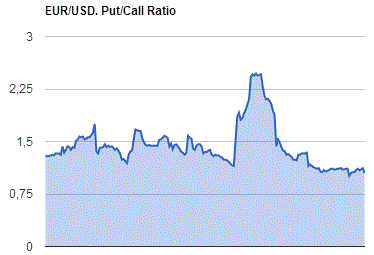
GBP/USD
Resistance levels (open interest**, contracts)
$1.3302 (2609)
$1.3205 (1334)
$1.3109 (995)
Price at time of writing this review: $1.3034
Support levels (open interest**, contracts):
$1.2994 (3593)
$1.2897 (848)
$1.2798 (1756)
Comments:
- Overall open interest on the CALL options with the expiration date October, 7 is 26084 contracts, with the maximum number of contracts with strike price $1,3500 (3374);
- Overall open interest on the PUT options with the expiration date October, 7 is 22263 contracts, with the maximum number of contracts with strike price $1,3000 (3593);
- The ratio of PUT/CALL was 0.85 versus 0.87 from the previous trading day according to data from September, 22
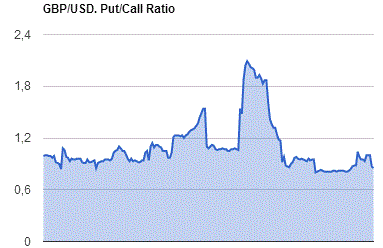
* - The Chicago Mercantile Exchange bulletin (CME) is used for the calculation.
** - Open interest takes into account the total number of option contracts that are open at the moment.
-
08:26
WSE: Before opening
Thursday's session on Wall Street ended with no surprises. Major averages recorded solidarity increases, the S&P500 index gained 0.65 percent and ended the day at levels similar to those observed after opening. Than this is a preview of neutral openings in Europe.
Today's macro calendar does not contain exciting events and from this perspective it is difficult to expect any fireworks. In the afternoon we will know the PMI index for the industry of the United States and earlier similar readings from Europe but there are not data that could have a decisive impact on the market. Markets seem to have today everything to look calm and consolidate after two days of reaction to the super-Wednesday. Moreover Europe has had four sessions of gains which may lead to profit taking.
On the Warsaw market situation is slightly different. Positive sentiment after the Fed decision, suitable for emerging markets, fighting in Warsaw with local political risk. Yesterday's decline in stock prices in the energy sector - triggered by announcements of the authorities about capital increasing, discourages foreign investors and minority shareholders to hold Polish shares and especially shares in companies owned by the Treasury. Thus, a good attitude to other emerging markets does not necessarily have to reflect with increases in the Warsaw index of the largest companies.
-
08:16
3 Reasons To Stay Bearish GBP - BNPP
"We expect the GBP to continue weakening for three main reasons
.First, stronger than expected UK data over the past month and a squeeze of short GBP positions have, according BNP Paribas STEER, driven the GBP above its its fair value implied by rates and equity markets - short-term fair value currently stands at 1.2890.
Second, the GBP remains vulnerable to political uncertainty which we think is likely to remain high near term.
Finally, our economists continue to forecast a 15bp rate cut at the Bank of England's November meeting - considerably more than the market is pricing in".
Copyright © 2016 BNP Paribas™, eFXnews™
-
08:15
Japan's all industry activity grew at a slower pace in July
According to rttnews, Japan's all industry activity grew at a slower pace in July, the Ministry of Economy, Trade and Industry said Friday.
The all industry activity index rose 0.3 percent month-on-month in July, following June's 1 percent increase. Nonetheless, this was the second consecutive rise in activity and better than the expected 0.2 percent growth.
Tertiary industry activity grew at a slower pace of 0.3 percent after rising 0.7 percent in the prior month.
Industrial output slid 0.4 percent on month, reversing a 2.3 percent rise a month ago. Meanwhile, the increase in construction activity accelerated to 2 percent from 0.1 percent.
On a yearly basis, the all industry activity index slid 0.7 percent in July in contrast to a 0.1 percent rise in June. This was the first fall in three months.
-
08:13
6.1 earthquake occurred near Off East Coast Of Honshu, Japan
-
08:12
Japan's manufacturing sector resumes expansion
Flash Japan Manufacturing PMI™ at 50.3 in September (49.5 in August). Manufacturing conditions improve marginally for the first time in seven months. Flash Japan Manufacturing Output Index at 50.7 (50.2 in August). Production increased for the second month running.
Today sees the latest public release of the Nikkei Flash Japan Manufacturing Purchasing Managers' Index™ (PMI™). Published on a monthly basis approximately one week before final PMI data are released, this makes the PMI the earliest available indicator of manufacturing sector operating conditions in Japan. The estimate is typically based on approximately 85%-90% of total PMI survey responses each month and is designed to provide an accurate indication of final PMI data.
Commenting on the Japanese Manufacturing PMI survey data, Amy Brownbill, economist at IHS Markit, which compiles the survey, said: "Manufacturing conditions in Japan improved for the first time since February at the end of Q3. Production increased for the second month running, while international demand picked up for the first time since the start of 2016. As a result, goods producers were more optimistic towards taking on additional staff, with job creation accelerating to a four-month high. Manufacturers also benefitted from lower cost burdens, with input prices declining for the ninth consecutive month."
-
06:46
Japan: All Industry Activity Index, m/m, July 0.3% (forecast 0.2%)
-
06:21
Global Stocks
European stock markets scored solid advances on Thursday after the U.S. Federal Reserve refrained from raising interest rates and said it needs more evidence of a stronger economy before it tightens policy. Mining and oil firms were among the biggest advancers, scoring a boost from a weaker dollar in the aftermath of the Fed decision, released after the European close on Wednesday.
U.S. stocks closed near session highs Thursday, with the Nasdaq Composite notching a record close, as investor enthusiasm following the Federal Reserve's most recent policy update spilled over into a second session. The Fed stood pat on interest rates on Wednesday, but Chairwoman Janet Yellen indicated a rate rise is likely by year-end as she expressed confidence in the U.S. economy. Better-than-expected weekly jobless claims data, which fell to the lowest tally since July, signaled a strong labor market and helped extend the optimistic tone on Wall Street.
Asian shares were mixed early Friday, with some markets seeing support amid easing worries that central banks globally would hike interest rates soon. Nonetheless, the currency retreated slightly against the U.S. dollar on Friday, on caution over a possible response from Japanese authorities against the yen's latest strength, after a meeting among top Japanese finance officials on Thursday.
-
02:37
Japan: Manufacturing PMI, September 50.3
-
00:29
Commodities. Daily history for Sep 22’2016:
(raw materials / closing price /% change)
Oil 46.08 -0.52%
Gold 1,340.70 -0.30%
-
00:29
Stocks. Daily history for Sep 22’2016:
(index / closing price / change items /% change)
Nikkei 225 16,807.62 +315.47 +1.91%
Shanghai Composite 3,042.69 +16.81 +0.56%
S&P/ASX 200 5,374.46 +34.90 +0.65%
FTSE 100 6,911.40 +76.63 +1.12%
CAC 40 4,509.82 +100.27 +2.27%
Xetra DAX 10,674.18 +237.69 +2.28%
S&P 500 2,177.18 +14.06 +0.65%
Dow Jones Industrial Average 18,392.46 +98.76 +0.54%
S&P/TSX Composite 14,797.18 +86.36 +0.59%
-
00:28
Currencies. Daily history for Sep 22’2016:
(pare/closed(GMT +3)/change, %)
EUR/USD $1,1207 +0,16%
GBP/USD $1,3076 +0,31%
USD/CHF Chf0,9686 -0,54%
USD/JPY Y100,78 +0,36%
EUR/JPY Y112,95 +0,50%
GBP/JPY Y131,77 +0,65%
AUD/USD $0,7641 +0,13%
NZD/USD $0,7312 -0,37%
USD/CAD C$1,3047 -0,35%
-
00:00
Schedule for today, Friday, Sep 23’2016
02:00 Japan Manufacturing PMI (Preliminary) September 49.5
04:30 Japan All Industry Activity Index, m/m July 1% 0.2%
07:00 France Services PMI (Preliminary) September 52.3 52
07:00 France Manufacturing PMI (Preliminary) September 48.3 48.4
07:30 Germany Services PMI (Preliminary) September 51.7 52.1
07:30 Germany Manufacturing PMI (Preliminary) September 53.6 53.1
08:00 Eurozone Services PMI (Preliminary) September 52.8 52.8
08:00 Eurozone Manufacturing PMI (Preliminary) September 51.7 51.5
12:30 Canada Retail Sales, m/m July -0.1% 0.1%
12:30 Canada Retail Sales YoY July 2.7%
12:30 Canada Retail Sales ex Autos, m/m July -0.8% 0.5
12:30 Canada Consumer Price Index m / m August -0.2% 0.1%
12:30 Canada Consumer price index, y/y August 1.3% 1.4%
12:30 Canada Bank of Canada Consumer Price Index Core, y/y August 2.1% 2%
13:00 Belgium Business Climate September -3.1 -2.4
13:45 U.S. Manufacturing PMI (Preliminary) September 52 51.9
-
